Analysis of HPCA 2003 Act: Roles, Ethics, and Standards in Healthcare
VerifiedAdded on 2023/06/05
|9
|2259
|50
Essay
AI Summary
This essay provides a comprehensive analysis of the Health Practitioners Competence Assurance (HPCA) Act 2003 in New Zealand. It outlines the scope and functions of the Act, emphasizing its role in ensuring safe and competent healthcare practices. The essay compares and contrasts the roles of nurses and dentists under the Act, highlighting both similarities in registration standards and differences in their specific duties. Furthermore, it examines the ethical codes and standards of practice for both professions, noting similarities in core values like respect and integrity, but also pointing out differences in the specific standards governing their professional conduct. The document concludes that while both professions are regulated under the HPCA Act to ensure competence and ethical behavior, their roles and specific standards of practice differ significantly.
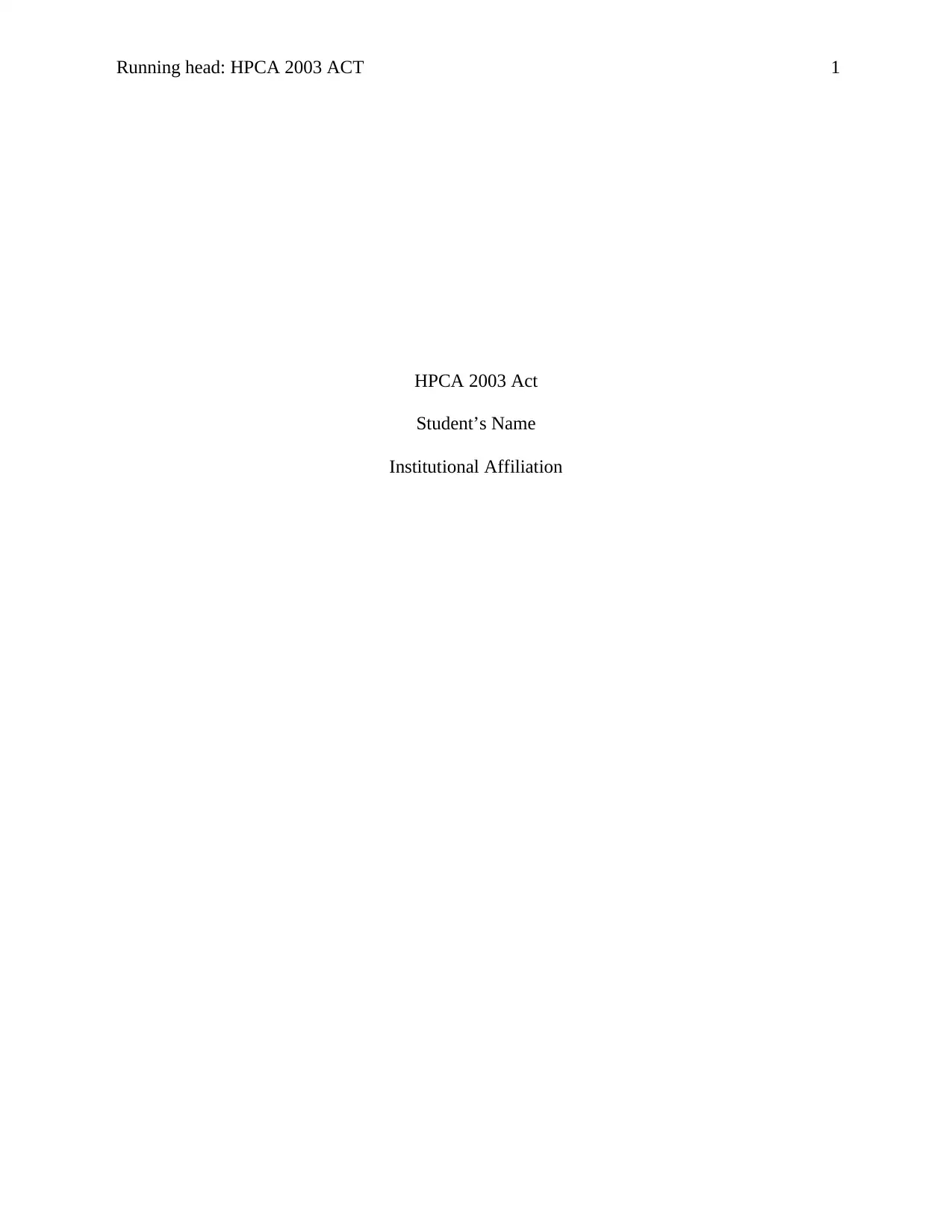
Running head: HPCA 2003 ACT 1
HPCA 2003 Act
Student’s Name
Institutional Affiliation
HPCA 2003 Act
Student’s Name
Institutional Affiliation
Paraphrase This Document
Need a fresh take? Get an instant paraphrase of this document with our AI Paraphraser
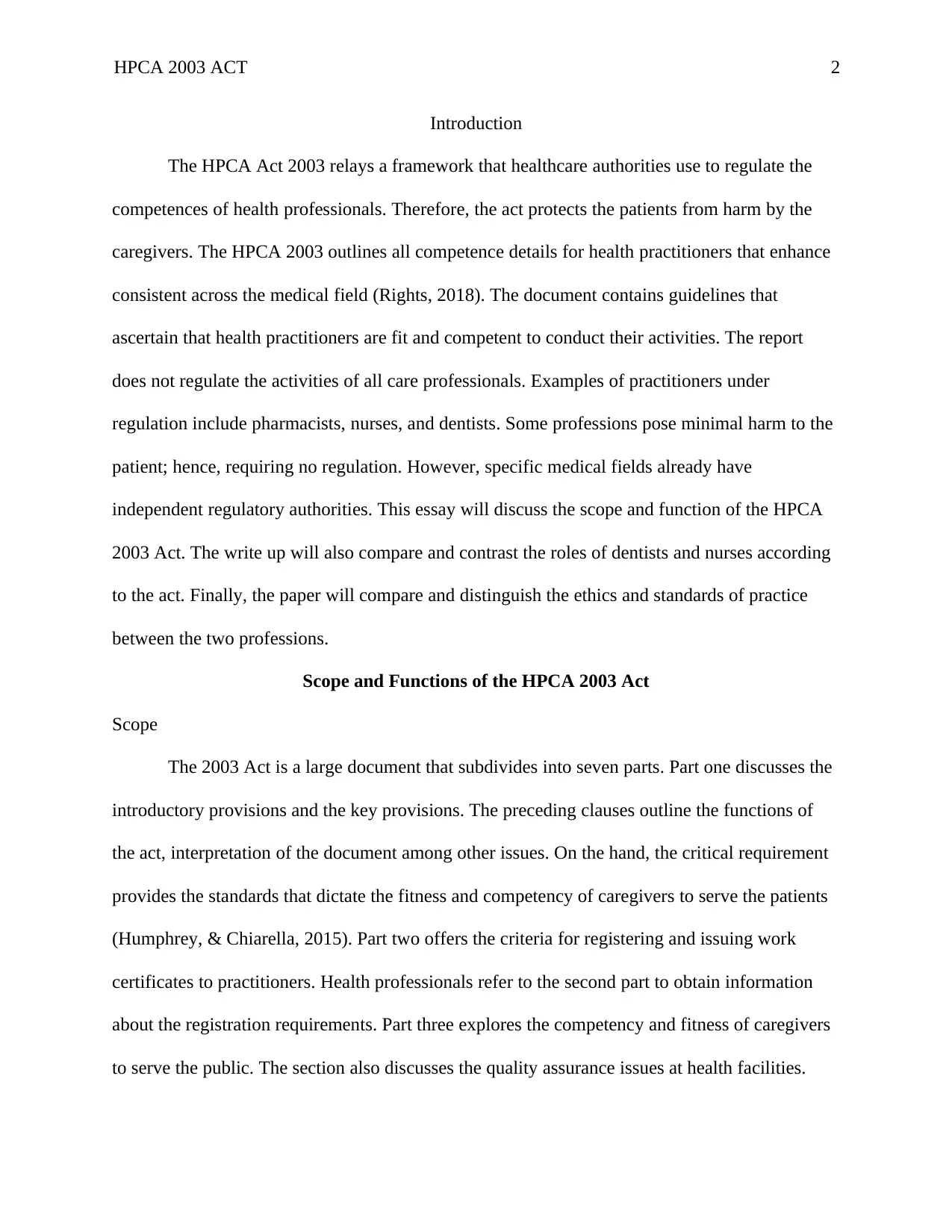
HPCA 2003 ACT 2
Introduction
The HPCA Act 2003 relays a framework that healthcare authorities use to regulate the
competences of health professionals. Therefore, the act protects the patients from harm by the
caregivers. The HPCA 2003 outlines all competence details for health practitioners that enhance
consistent across the medical field (Rights, 2018). The document contains guidelines that
ascertain that health practitioners are fit and competent to conduct their activities. The report
does not regulate the activities of all care professionals. Examples of practitioners under
regulation include pharmacists, nurses, and dentists. Some professions pose minimal harm to the
patient; hence, requiring no regulation. However, specific medical fields already have
independent regulatory authorities. This essay will discuss the scope and function of the HPCA
2003 Act. The write up will also compare and contrast the roles of dentists and nurses according
to the act. Finally, the paper will compare and distinguish the ethics and standards of practice
between the two professions.
Scope and Functions of the HPCA 2003 Act
Scope
The 2003 Act is a large document that subdivides into seven parts. Part one discusses the
introductory provisions and the key provisions. The preceding clauses outline the functions of
the act, interpretation of the document among other issues. On the hand, the critical requirement
provides the standards that dictate the fitness and competency of caregivers to serve the patients
(Humphrey, & Chiarella, 2015). Part two offers the criteria for registering and issuing work
certificates to practitioners. Health professionals refer to the second part to obtain information
about the registration requirements. Part three explores the competency and fitness of caregivers
to serve the public. The section also discusses the quality assurance issues at health facilities.
Introduction
The HPCA Act 2003 relays a framework that healthcare authorities use to regulate the
competences of health professionals. Therefore, the act protects the patients from harm by the
caregivers. The HPCA 2003 outlines all competence details for health practitioners that enhance
consistent across the medical field (Rights, 2018). The document contains guidelines that
ascertain that health practitioners are fit and competent to conduct their activities. The report
does not regulate the activities of all care professionals. Examples of practitioners under
regulation include pharmacists, nurses, and dentists. Some professions pose minimal harm to the
patient; hence, requiring no regulation. However, specific medical fields already have
independent regulatory authorities. This essay will discuss the scope and function of the HPCA
2003 Act. The write up will also compare and contrast the roles of dentists and nurses according
to the act. Finally, the paper will compare and distinguish the ethics and standards of practice
between the two professions.
Scope and Functions of the HPCA 2003 Act
Scope
The 2003 Act is a large document that subdivides into seven parts. Part one discusses the
introductory provisions and the key provisions. The preceding clauses outline the functions of
the act, interpretation of the document among other issues. On the hand, the critical requirement
provides the standards that dictate the fitness and competency of caregivers to serve the patients
(Humphrey, & Chiarella, 2015). Part two offers the criteria for registering and issuing work
certificates to practitioners. Health professionals refer to the second part to obtain information
about the registration requirements. Part three explores the competency and fitness of caregivers
to serve the public. The section also discusses the quality assurance issues at health facilities.
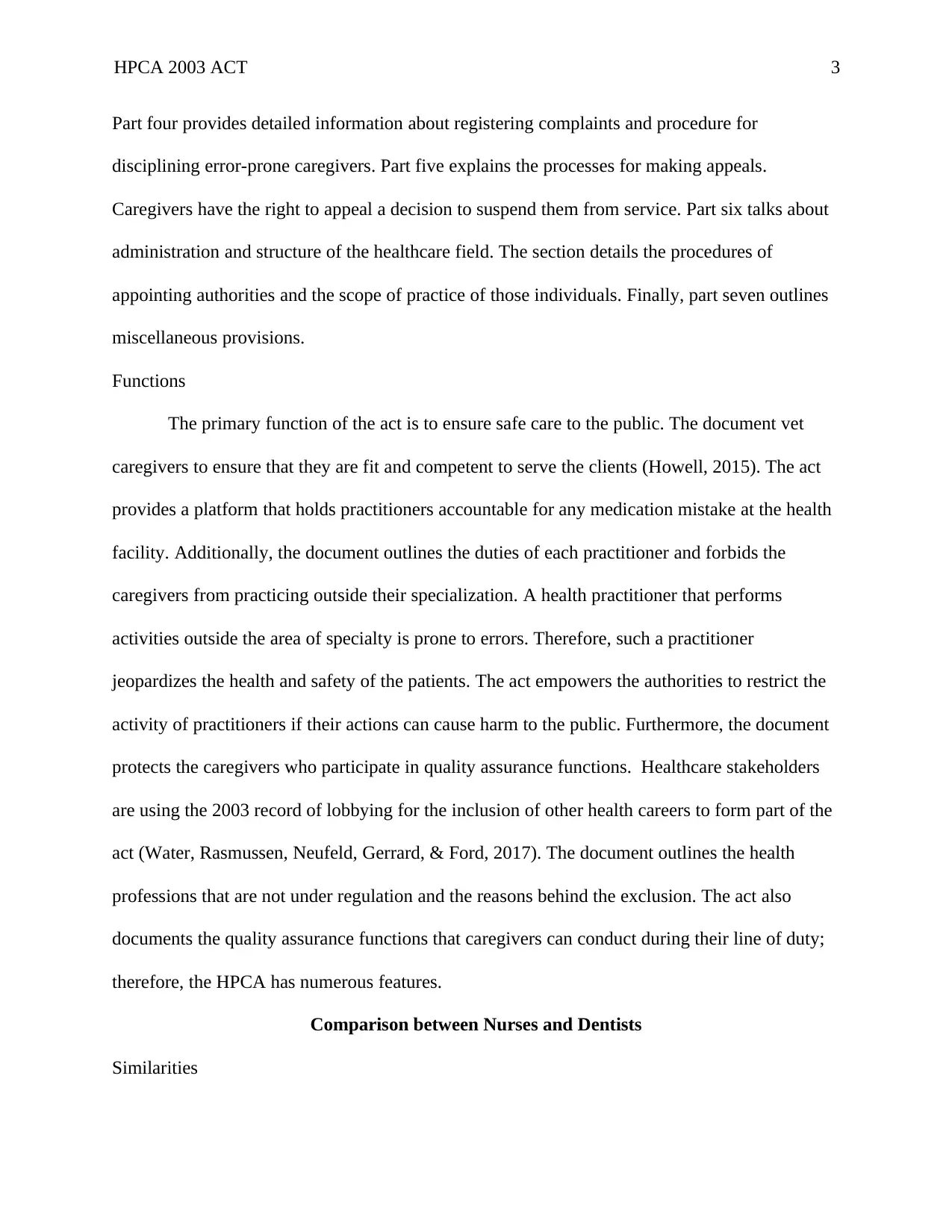
HPCA 2003 ACT 3
Part four provides detailed information about registering complaints and procedure for
disciplining error-prone caregivers. Part five explains the processes for making appeals.
Caregivers have the right to appeal a decision to suspend them from service. Part six talks about
administration and structure of the healthcare field. The section details the procedures of
appointing authorities and the scope of practice of those individuals. Finally, part seven outlines
miscellaneous provisions.
Functions
The primary function of the act is to ensure safe care to the public. The document vet
caregivers to ensure that they are fit and competent to serve the clients (Howell, 2015). The act
provides a platform that holds practitioners accountable for any medication mistake at the health
facility. Additionally, the document outlines the duties of each practitioner and forbids the
caregivers from practicing outside their specialization. A health practitioner that performs
activities outside the area of specialty is prone to errors. Therefore, such a practitioner
jeopardizes the health and safety of the patients. The act empowers the authorities to restrict the
activity of practitioners if their actions can cause harm to the public. Furthermore, the document
protects the caregivers who participate in quality assurance functions. Healthcare stakeholders
are using the 2003 record of lobbying for the inclusion of other health careers to form part of the
act (Water, Rasmussen, Neufeld, Gerrard, & Ford, 2017). The document outlines the health
professions that are not under regulation and the reasons behind the exclusion. The act also
documents the quality assurance functions that caregivers can conduct during their line of duty;
therefore, the HPCA has numerous features.
Comparison between Nurses and Dentists
Similarities
Part four provides detailed information about registering complaints and procedure for
disciplining error-prone caregivers. Part five explains the processes for making appeals.
Caregivers have the right to appeal a decision to suspend them from service. Part six talks about
administration and structure of the healthcare field. The section details the procedures of
appointing authorities and the scope of practice of those individuals. Finally, part seven outlines
miscellaneous provisions.
Functions
The primary function of the act is to ensure safe care to the public. The document vet
caregivers to ensure that they are fit and competent to serve the clients (Howell, 2015). The act
provides a platform that holds practitioners accountable for any medication mistake at the health
facility. Additionally, the document outlines the duties of each practitioner and forbids the
caregivers from practicing outside their specialization. A health practitioner that performs
activities outside the area of specialty is prone to errors. Therefore, such a practitioner
jeopardizes the health and safety of the patients. The act empowers the authorities to restrict the
activity of practitioners if their actions can cause harm to the public. Furthermore, the document
protects the caregivers who participate in quality assurance functions. Healthcare stakeholders
are using the 2003 record of lobbying for the inclusion of other health careers to form part of the
act (Water, Rasmussen, Neufeld, Gerrard, & Ford, 2017). The document outlines the health
professions that are not under regulation and the reasons behind the exclusion. The act also
documents the quality assurance functions that caregivers can conduct during their line of duty;
therefore, the HPCA has numerous features.
Comparison between Nurses and Dentists
Similarities
⊘ This is a preview!⊘
Do you want full access?
Subscribe today to unlock all pages.

Trusted by 1+ million students worldwide
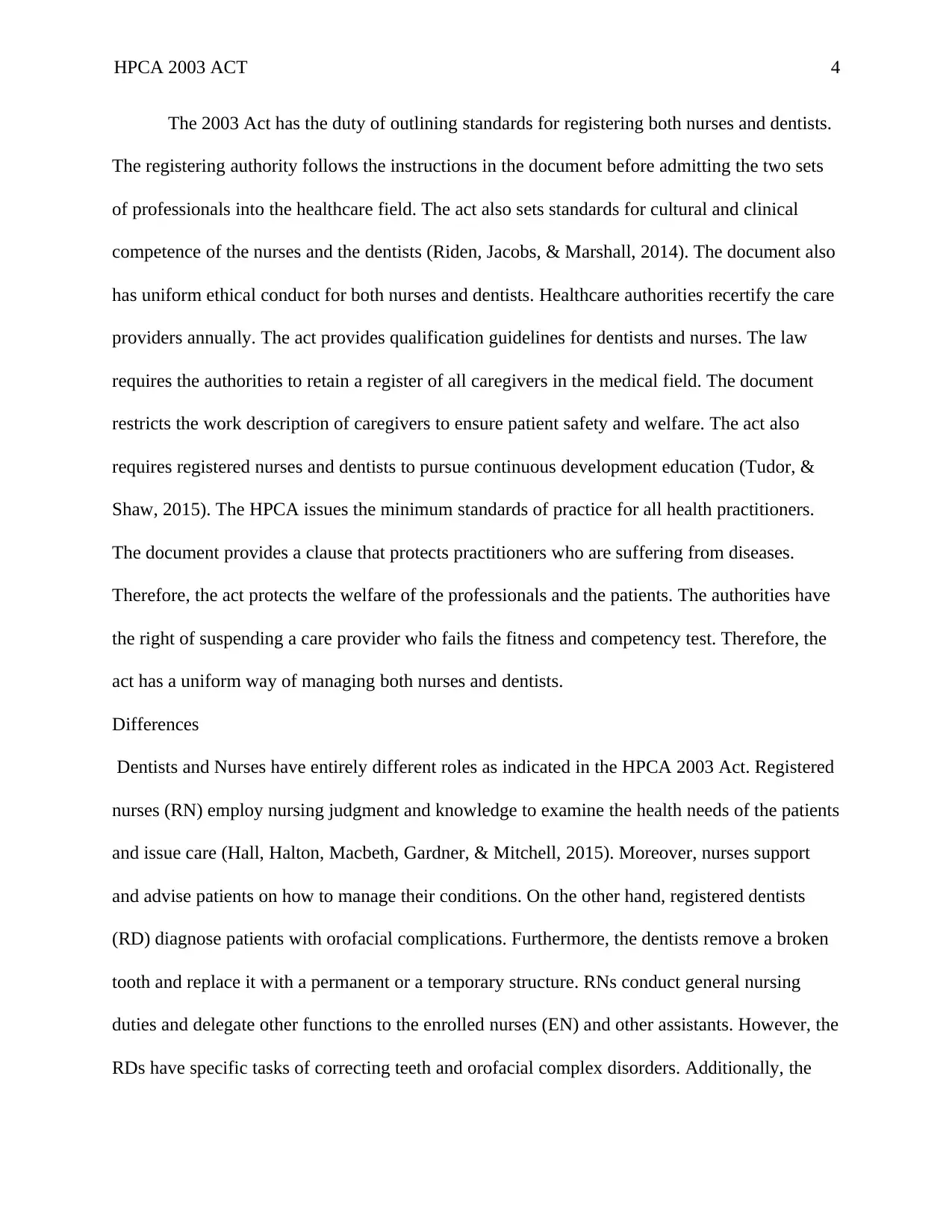
HPCA 2003 ACT 4
The 2003 Act has the duty of outlining standards for registering both nurses and dentists.
The registering authority follows the instructions in the document before admitting the two sets
of professionals into the healthcare field. The act also sets standards for cultural and clinical
competence of the nurses and the dentists (Riden, Jacobs, & Marshall, 2014). The document also
has uniform ethical conduct for both nurses and dentists. Healthcare authorities recertify the care
providers annually. The act provides qualification guidelines for dentists and nurses. The law
requires the authorities to retain a register of all caregivers in the medical field. The document
restricts the work description of caregivers to ensure patient safety and welfare. The act also
requires registered nurses and dentists to pursue continuous development education (Tudor, &
Shaw, 2015). The HPCA issues the minimum standards of practice for all health practitioners.
The document provides a clause that protects practitioners who are suffering from diseases.
Therefore, the act protects the welfare of the professionals and the patients. The authorities have
the right of suspending a care provider who fails the fitness and competency test. Therefore, the
act has a uniform way of managing both nurses and dentists.
Differences
Dentists and Nurses have entirely different roles as indicated in the HPCA 2003 Act. Registered
nurses (RN) employ nursing judgment and knowledge to examine the health needs of the patients
and issue care (Hall, Halton, Macbeth, Gardner, & Mitchell, 2015). Moreover, nurses support
and advise patients on how to manage their conditions. On the other hand, registered dentists
(RD) diagnose patients with orofacial complications. Furthermore, the dentists remove a broken
tooth and replace it with a permanent or a temporary structure. RNs conduct general nursing
duties and delegate other functions to the enrolled nurses (EN) and other assistants. However, the
RDs have specific tasks of correcting teeth and orofacial complex disorders. Additionally, the
The 2003 Act has the duty of outlining standards for registering both nurses and dentists.
The registering authority follows the instructions in the document before admitting the two sets
of professionals into the healthcare field. The act also sets standards for cultural and clinical
competence of the nurses and the dentists (Riden, Jacobs, & Marshall, 2014). The document also
has uniform ethical conduct for both nurses and dentists. Healthcare authorities recertify the care
providers annually. The act provides qualification guidelines for dentists and nurses. The law
requires the authorities to retain a register of all caregivers in the medical field. The document
restricts the work description of caregivers to ensure patient safety and welfare. The act also
requires registered nurses and dentists to pursue continuous development education (Tudor, &
Shaw, 2015). The HPCA issues the minimum standards of practice for all health practitioners.
The document provides a clause that protects practitioners who are suffering from diseases.
Therefore, the act protects the welfare of the professionals and the patients. The authorities have
the right of suspending a care provider who fails the fitness and competency test. Therefore, the
act has a uniform way of managing both nurses and dentists.
Differences
Dentists and Nurses have entirely different roles as indicated in the HPCA 2003 Act. Registered
nurses (RN) employ nursing judgment and knowledge to examine the health needs of the patients
and issue care (Hall, Halton, Macbeth, Gardner, & Mitchell, 2015). Moreover, nurses support
and advise patients on how to manage their conditions. On the other hand, registered dentists
(RD) diagnose patients with orofacial complications. Furthermore, the dentists remove a broken
tooth and replace it with a permanent or a temporary structure. RNs conduct general nursing
duties and delegate other functions to the enrolled nurses (EN) and other assistants. However, the
RDs have specific tasks of correcting teeth and orofacial complex disorders. Additionally, the
Paraphrase This Document
Need a fresh take? Get an instant paraphrase of this document with our AI Paraphraser
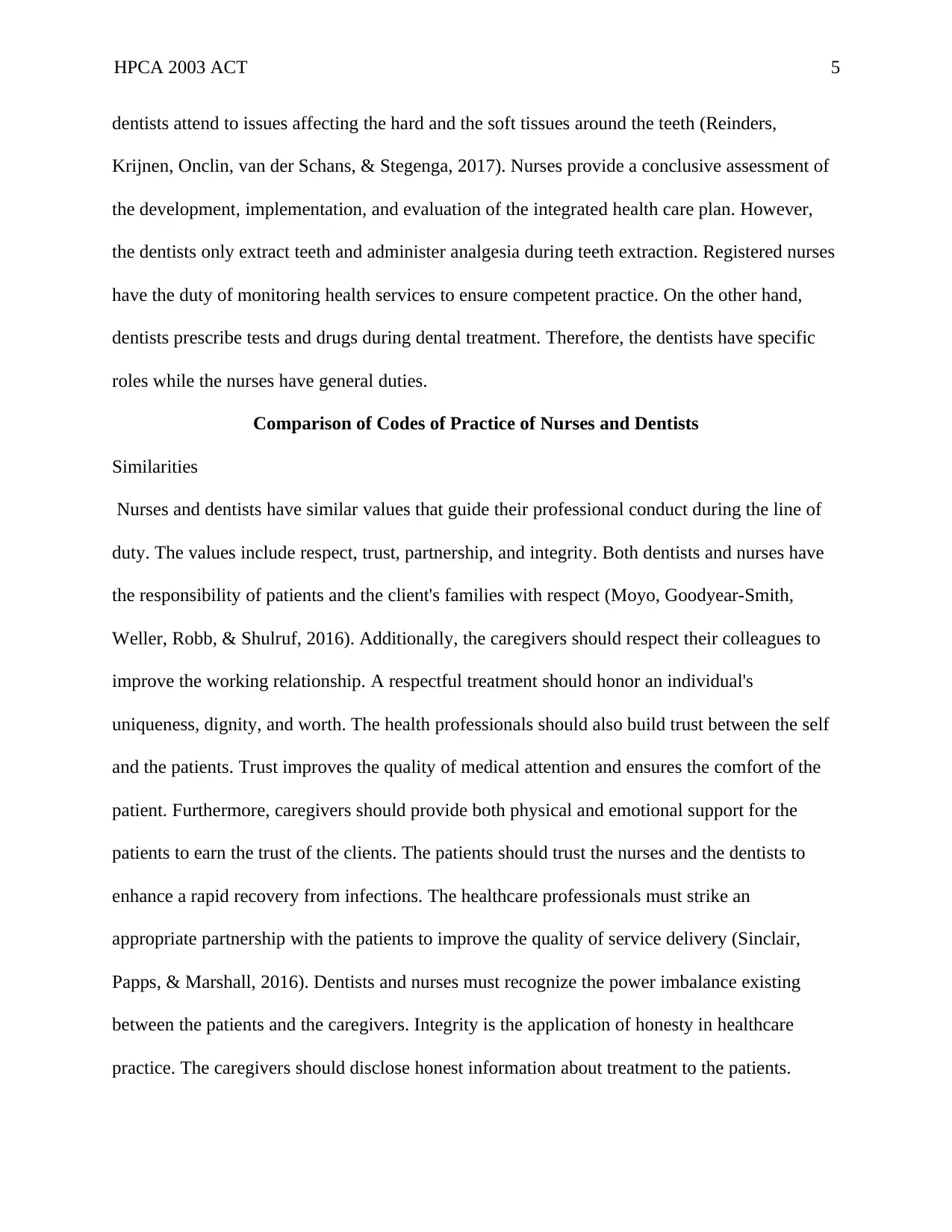
HPCA 2003 ACT 5
dentists attend to issues affecting the hard and the soft tissues around the teeth (Reinders,
Krijnen, Onclin, van der Schans, & Stegenga, 2017). Nurses provide a conclusive assessment of
the development, implementation, and evaluation of the integrated health care plan. However,
the dentists only extract teeth and administer analgesia during teeth extraction. Registered nurses
have the duty of monitoring health services to ensure competent practice. On the other hand,
dentists prescribe tests and drugs during dental treatment. Therefore, the dentists have specific
roles while the nurses have general duties.
Comparison of Codes of Practice of Nurses and Dentists
Similarities
Nurses and dentists have similar values that guide their professional conduct during the line of
duty. The values include respect, trust, partnership, and integrity. Both dentists and nurses have
the responsibility of patients and the client's families with respect (Moyo, Goodyear-Smith,
Weller, Robb, & Shulruf, 2016). Additionally, the caregivers should respect their colleagues to
improve the working relationship. A respectful treatment should honor an individual's
uniqueness, dignity, and worth. The health professionals should also build trust between the self
and the patients. Trust improves the quality of medical attention and ensures the comfort of the
patient. Furthermore, caregivers should provide both physical and emotional support for the
patients to earn the trust of the clients. The patients should trust the nurses and the dentists to
enhance a rapid recovery from infections. The healthcare professionals must strike an
appropriate partnership with the patients to improve the quality of service delivery (Sinclair,
Papps, & Marshall, 2016). Dentists and nurses must recognize the power imbalance existing
between the patients and the caregivers. Integrity is the application of honesty in healthcare
practice. The caregivers should disclose honest information about treatment to the patients.
dentists attend to issues affecting the hard and the soft tissues around the teeth (Reinders,
Krijnen, Onclin, van der Schans, & Stegenga, 2017). Nurses provide a conclusive assessment of
the development, implementation, and evaluation of the integrated health care plan. However,
the dentists only extract teeth and administer analgesia during teeth extraction. Registered nurses
have the duty of monitoring health services to ensure competent practice. On the other hand,
dentists prescribe tests and drugs during dental treatment. Therefore, the dentists have specific
roles while the nurses have general duties.
Comparison of Codes of Practice of Nurses and Dentists
Similarities
Nurses and dentists have similar values that guide their professional conduct during the line of
duty. The values include respect, trust, partnership, and integrity. Both dentists and nurses have
the responsibility of patients and the client's families with respect (Moyo, Goodyear-Smith,
Weller, Robb, & Shulruf, 2016). Additionally, the caregivers should respect their colleagues to
improve the working relationship. A respectful treatment should honor an individual's
uniqueness, dignity, and worth. The health professionals should also build trust between the self
and the patients. Trust improves the quality of medical attention and ensures the comfort of the
patient. Furthermore, caregivers should provide both physical and emotional support for the
patients to earn the trust of the clients. The patients should trust the nurses and the dentists to
enhance a rapid recovery from infections. The healthcare professionals must strike an
appropriate partnership with the patients to improve the quality of service delivery (Sinclair,
Papps, & Marshall, 2016). Dentists and nurses must recognize the power imbalance existing
between the patients and the caregivers. Integrity is the application of honesty in healthcare
practice. The caregivers should disclose honest information about treatment to the patients.
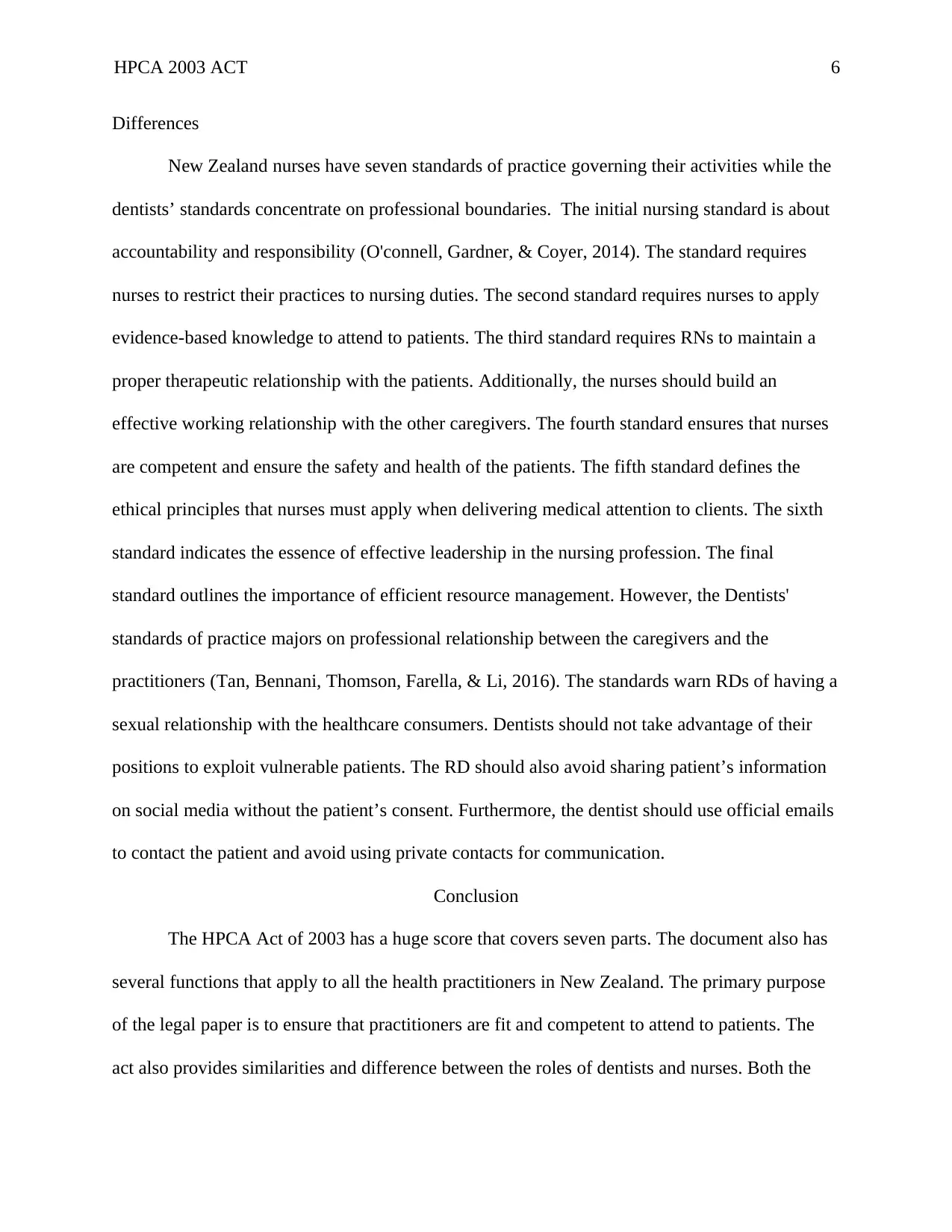
HPCA 2003 ACT 6
Differences
New Zealand nurses have seven standards of practice governing their activities while the
dentists’ standards concentrate on professional boundaries. The initial nursing standard is about
accountability and responsibility (O'connell, Gardner, & Coyer, 2014). The standard requires
nurses to restrict their practices to nursing duties. The second standard requires nurses to apply
evidence-based knowledge to attend to patients. The third standard requires RNs to maintain a
proper therapeutic relationship with the patients. Additionally, the nurses should build an
effective working relationship with the other caregivers. The fourth standard ensures that nurses
are competent and ensure the safety and health of the patients. The fifth standard defines the
ethical principles that nurses must apply when delivering medical attention to clients. The sixth
standard indicates the essence of effective leadership in the nursing profession. The final
standard outlines the importance of efficient resource management. However, the Dentists'
standards of practice majors on professional relationship between the caregivers and the
practitioners (Tan, Bennani, Thomson, Farella, & Li, 2016). The standards warn RDs of having a
sexual relationship with the healthcare consumers. Dentists should not take advantage of their
positions to exploit vulnerable patients. The RD should also avoid sharing patient’s information
on social media without the patient’s consent. Furthermore, the dentist should use official emails
to contact the patient and avoid using private contacts for communication.
Conclusion
The HPCA Act of 2003 has a huge score that covers seven parts. The document also has
several functions that apply to all the health practitioners in New Zealand. The primary purpose
of the legal paper is to ensure that practitioners are fit and competent to attend to patients. The
act also provides similarities and difference between the roles of dentists and nurses. Both the
Differences
New Zealand nurses have seven standards of practice governing their activities while the
dentists’ standards concentrate on professional boundaries. The initial nursing standard is about
accountability and responsibility (O'connell, Gardner, & Coyer, 2014). The standard requires
nurses to restrict their practices to nursing duties. The second standard requires nurses to apply
evidence-based knowledge to attend to patients. The third standard requires RNs to maintain a
proper therapeutic relationship with the patients. Additionally, the nurses should build an
effective working relationship with the other caregivers. The fourth standard ensures that nurses
are competent and ensure the safety and health of the patients. The fifth standard defines the
ethical principles that nurses must apply when delivering medical attention to clients. The sixth
standard indicates the essence of effective leadership in the nursing profession. The final
standard outlines the importance of efficient resource management. However, the Dentists'
standards of practice majors on professional relationship between the caregivers and the
practitioners (Tan, Bennani, Thomson, Farella, & Li, 2016). The standards warn RDs of having a
sexual relationship with the healthcare consumers. Dentists should not take advantage of their
positions to exploit vulnerable patients. The RD should also avoid sharing patient’s information
on social media without the patient’s consent. Furthermore, the dentist should use official emails
to contact the patient and avoid using private contacts for communication.
Conclusion
The HPCA Act of 2003 has a huge score that covers seven parts. The document also has
several functions that apply to all the health practitioners in New Zealand. The primary purpose
of the legal paper is to ensure that practitioners are fit and competent to attend to patients. The
act also provides similarities and difference between the roles of dentists and nurses. Both the
⊘ This is a preview!⊘
Do you want full access?
Subscribe today to unlock all pages.

Trusted by 1+ million students worldwide
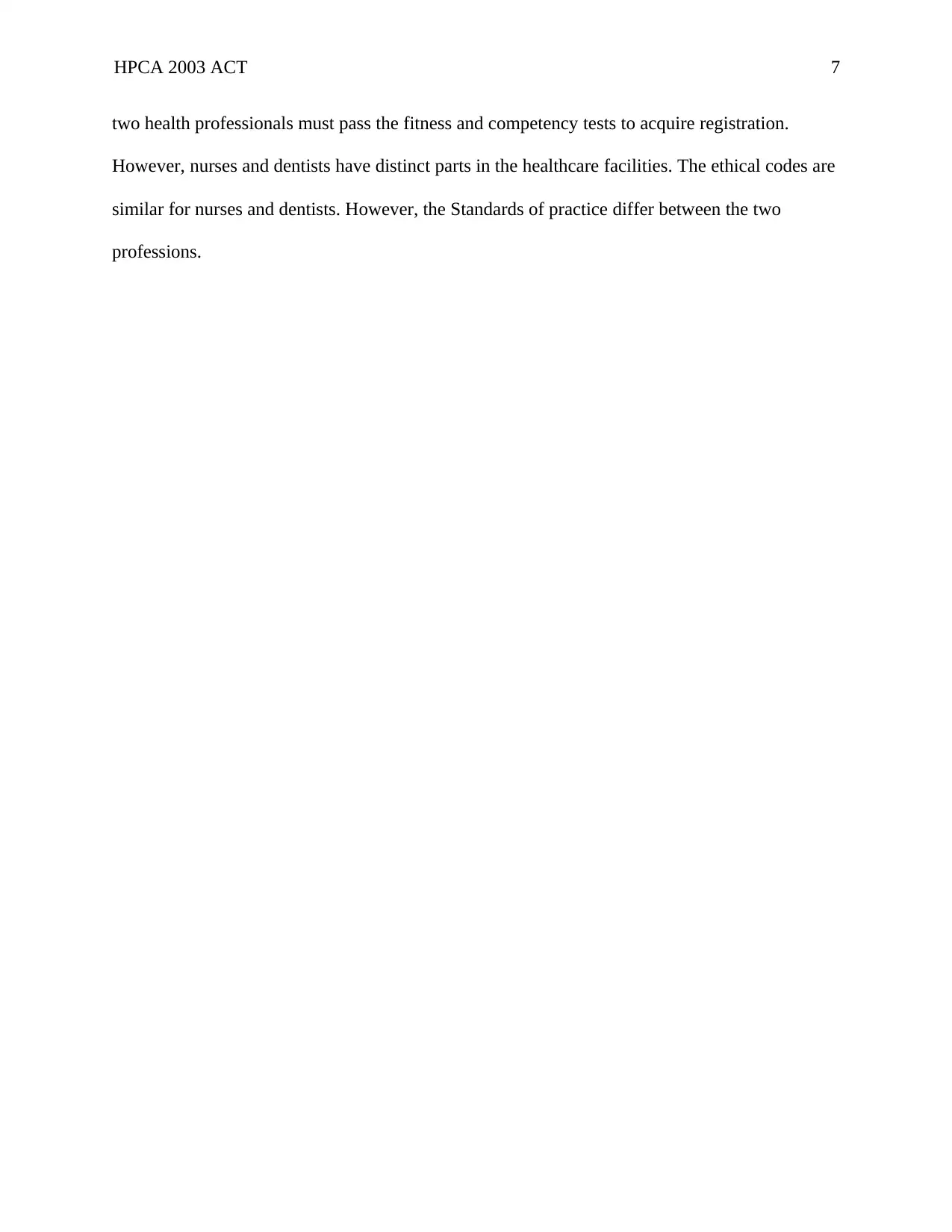
HPCA 2003 ACT 7
two health professionals must pass the fitness and competency tests to acquire registration.
However, nurses and dentists have distinct parts in the healthcare facilities. The ethical codes are
similar for nurses and dentists. However, the Standards of practice differ between the two
professions.
two health professionals must pass the fitness and competency tests to acquire registration.
However, nurses and dentists have distinct parts in the healthcare facilities. The ethical codes are
similar for nurses and dentists. However, the Standards of practice differ between the two
professions.
Paraphrase This Document
Need a fresh take? Get an instant paraphrase of this document with our AI Paraphraser
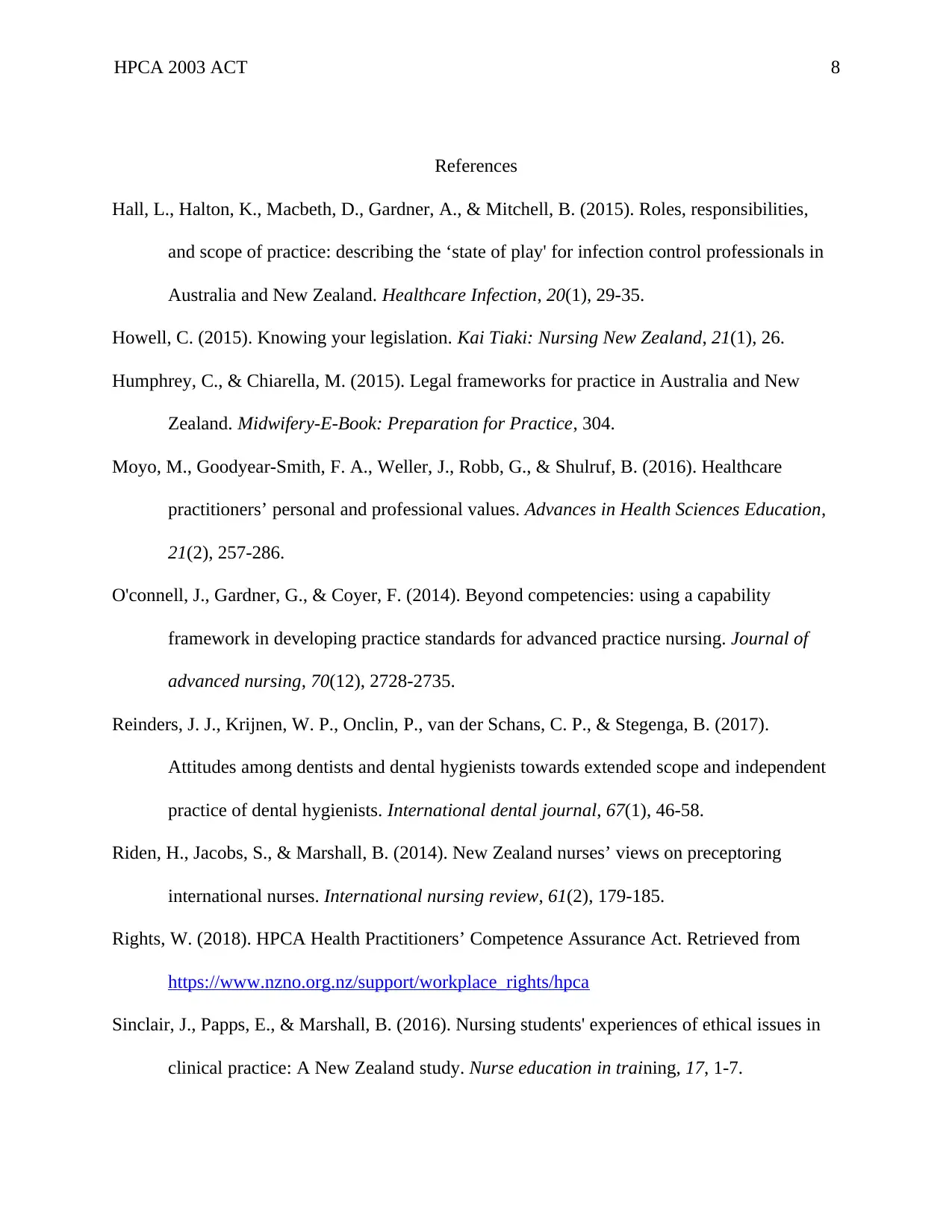
HPCA 2003 ACT 8
References
Hall, L., Halton, K., Macbeth, D., Gardner, A., & Mitchell, B. (2015). Roles, responsibilities,
and scope of practice: describing the ‘state of play' for infection control professionals in
Australia and New Zealand. Healthcare Infection, 20(1), 29-35.
Howell, C. (2015). Knowing your legislation. Kai Tiaki: Nursing New Zealand, 21(1), 26.
Humphrey, C., & Chiarella, M. (2015). Legal frameworks for practice in Australia and New
Zealand. Midwifery-E-Book: Preparation for Practice, 304.
Moyo, M., Goodyear-Smith, F. A., Weller, J., Robb, G., & Shulruf, B. (2016). Healthcare
practitioners’ personal and professional values. Advances in Health Sciences Education,
21(2), 257-286.
O'connell, J., Gardner, G., & Coyer, F. (2014). Beyond competencies: using a capability
framework in developing practice standards for advanced practice nursing. Journal of
advanced nursing, 70(12), 2728-2735.
Reinders, J. J., Krijnen, W. P., Onclin, P., van der Schans, C. P., & Stegenga, B. (2017).
Attitudes among dentists and dental hygienists towards extended scope and independent
practice of dental hygienists. International dental journal, 67(1), 46-58.
Riden, H., Jacobs, S., & Marshall, B. (2014). New Zealand nurses’ views on preceptoring
international nurses. International nursing review, 61(2), 179-185.
Rights, W. (2018). HPCA Health Practitioners’ Competence Assurance Act. Retrieved from
https://www.nzno.org.nz/support/workplace_rights/hpca
Sinclair, J., Papps, E., & Marshall, B. (2016). Nursing students' experiences of ethical issues in
clinical practice: A New Zealand study. Nurse education in training, 17, 1-7.
References
Hall, L., Halton, K., Macbeth, D., Gardner, A., & Mitchell, B. (2015). Roles, responsibilities,
and scope of practice: describing the ‘state of play' for infection control professionals in
Australia and New Zealand. Healthcare Infection, 20(1), 29-35.
Howell, C. (2015). Knowing your legislation. Kai Tiaki: Nursing New Zealand, 21(1), 26.
Humphrey, C., & Chiarella, M. (2015). Legal frameworks for practice in Australia and New
Zealand. Midwifery-E-Book: Preparation for Practice, 304.
Moyo, M., Goodyear-Smith, F. A., Weller, J., Robb, G., & Shulruf, B. (2016). Healthcare
practitioners’ personal and professional values. Advances in Health Sciences Education,
21(2), 257-286.
O'connell, J., Gardner, G., & Coyer, F. (2014). Beyond competencies: using a capability
framework in developing practice standards for advanced practice nursing. Journal of
advanced nursing, 70(12), 2728-2735.
Reinders, J. J., Krijnen, W. P., Onclin, P., van der Schans, C. P., & Stegenga, B. (2017).
Attitudes among dentists and dental hygienists towards extended scope and independent
practice of dental hygienists. International dental journal, 67(1), 46-58.
Riden, H., Jacobs, S., & Marshall, B. (2014). New Zealand nurses’ views on preceptoring
international nurses. International nursing review, 61(2), 179-185.
Rights, W. (2018). HPCA Health Practitioners’ Competence Assurance Act. Retrieved from
https://www.nzno.org.nz/support/workplace_rights/hpca
Sinclair, J., Papps, E., & Marshall, B. (2016). Nursing students' experiences of ethical issues in
clinical practice: A New Zealand study. Nurse education in training, 17, 1-7.
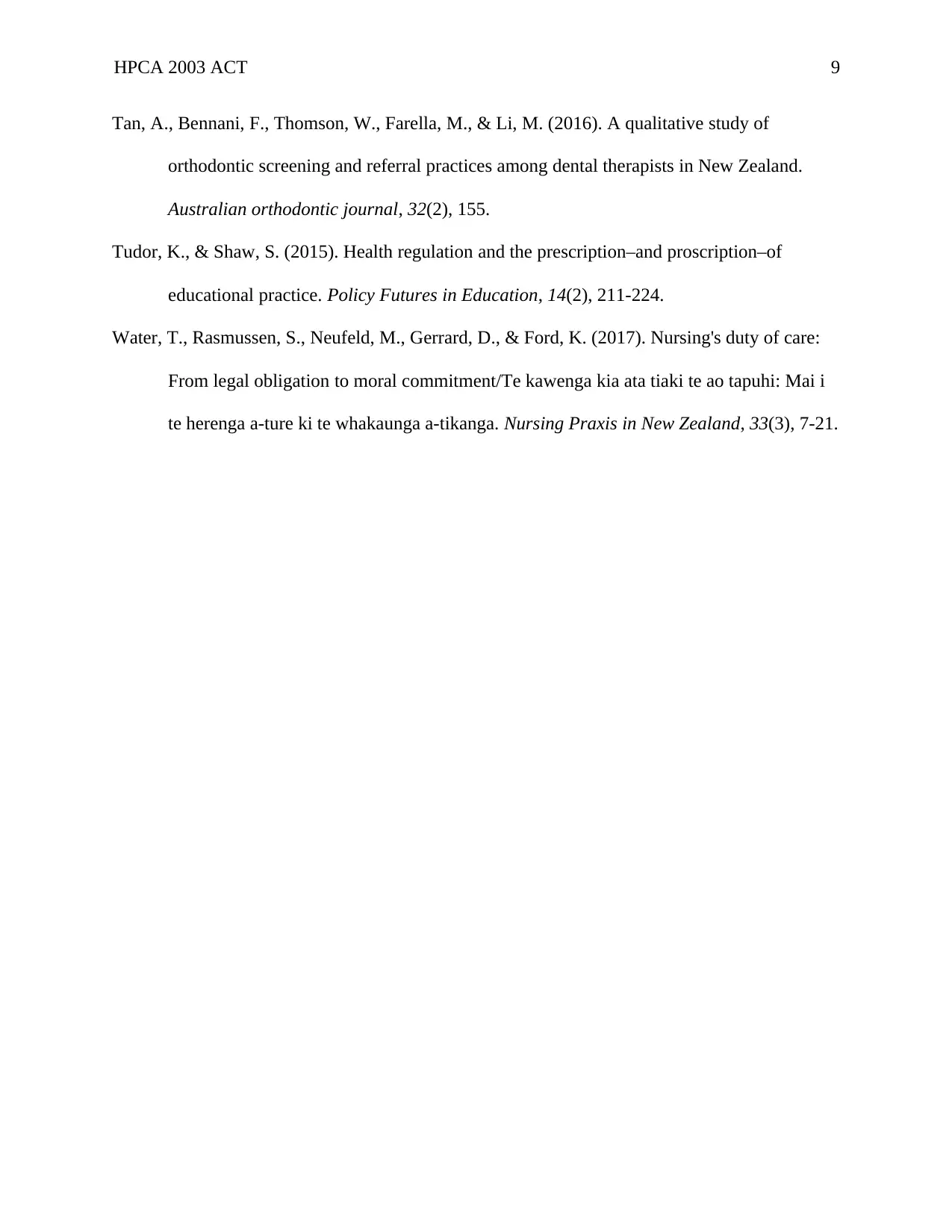
HPCA 2003 ACT 9
Tan, A., Bennani, F., Thomson, W., Farella, M., & Li, M. (2016). A qualitative study of
orthodontic screening and referral practices among dental therapists in New Zealand.
Australian orthodontic journal, 32(2), 155.
Tudor, K., & Shaw, S. (2015). Health regulation and the prescription–and proscription–of
educational practice. Policy Futures in Education, 14(2), 211-224.
Water, T., Rasmussen, S., Neufeld, M., Gerrard, D., & Ford, K. (2017). Nursing's duty of care:
From legal obligation to moral commitment/Te kawenga kia ata tiaki te ao tapuhi: Mai i
te herenga a-ture ki te whakaunga a-tikanga. Nursing Praxis in New Zealand, 33(3), 7-21.
Tan, A., Bennani, F., Thomson, W., Farella, M., & Li, M. (2016). A qualitative study of
orthodontic screening and referral practices among dental therapists in New Zealand.
Australian orthodontic journal, 32(2), 155.
Tudor, K., & Shaw, S. (2015). Health regulation and the prescription–and proscription–of
educational practice. Policy Futures in Education, 14(2), 211-224.
Water, T., Rasmussen, S., Neufeld, M., Gerrard, D., & Ford, K. (2017). Nursing's duty of care:
From legal obligation to moral commitment/Te kawenga kia ata tiaki te ao tapuhi: Mai i
te herenga a-ture ki te whakaunga a-tikanga. Nursing Praxis in New Zealand, 33(3), 7-21.
⊘ This is a preview!⊘
Do you want full access?
Subscribe today to unlock all pages.

Trusted by 1+ million students worldwide
1 out of 9
Related Documents
Your All-in-One AI-Powered Toolkit for Academic Success.
+13062052269
info@desklib.com
Available 24*7 on WhatsApp / Email
![[object Object]](/_next/static/media/star-bottom.7253800d.svg)
Unlock your academic potential
Copyright © 2020–2025 A2Z Services. All Rights Reserved. Developed and managed by ZUCOL.



